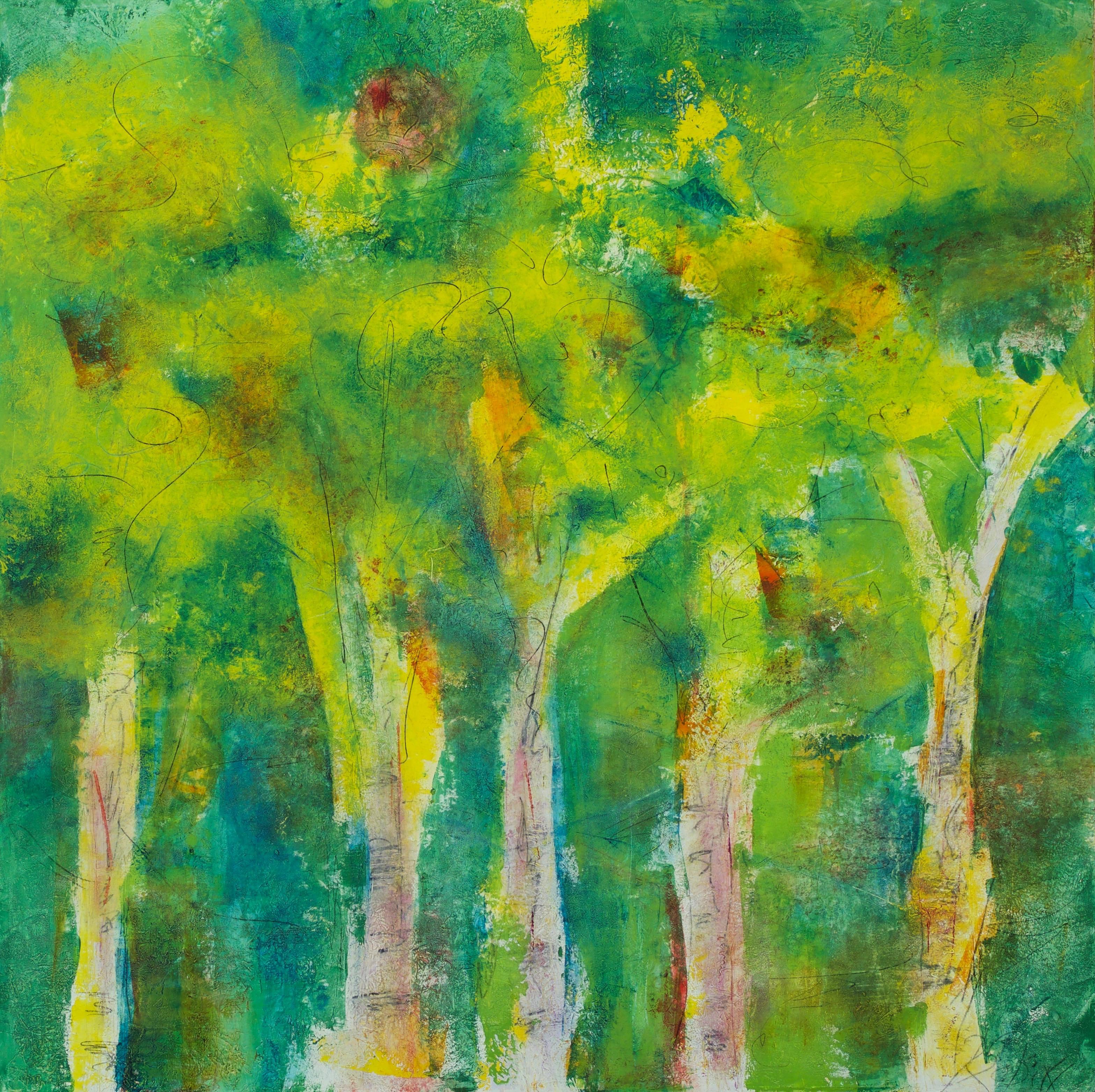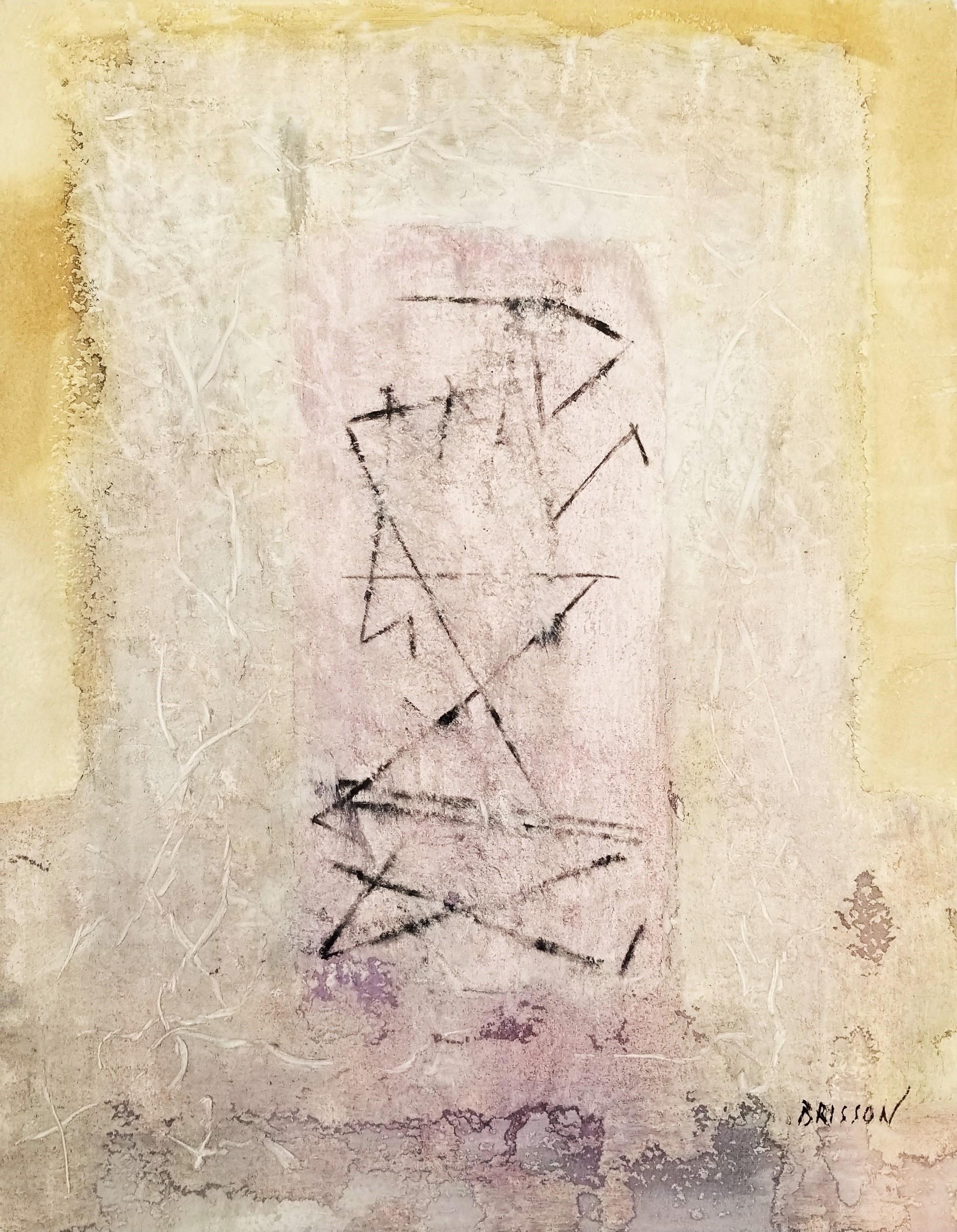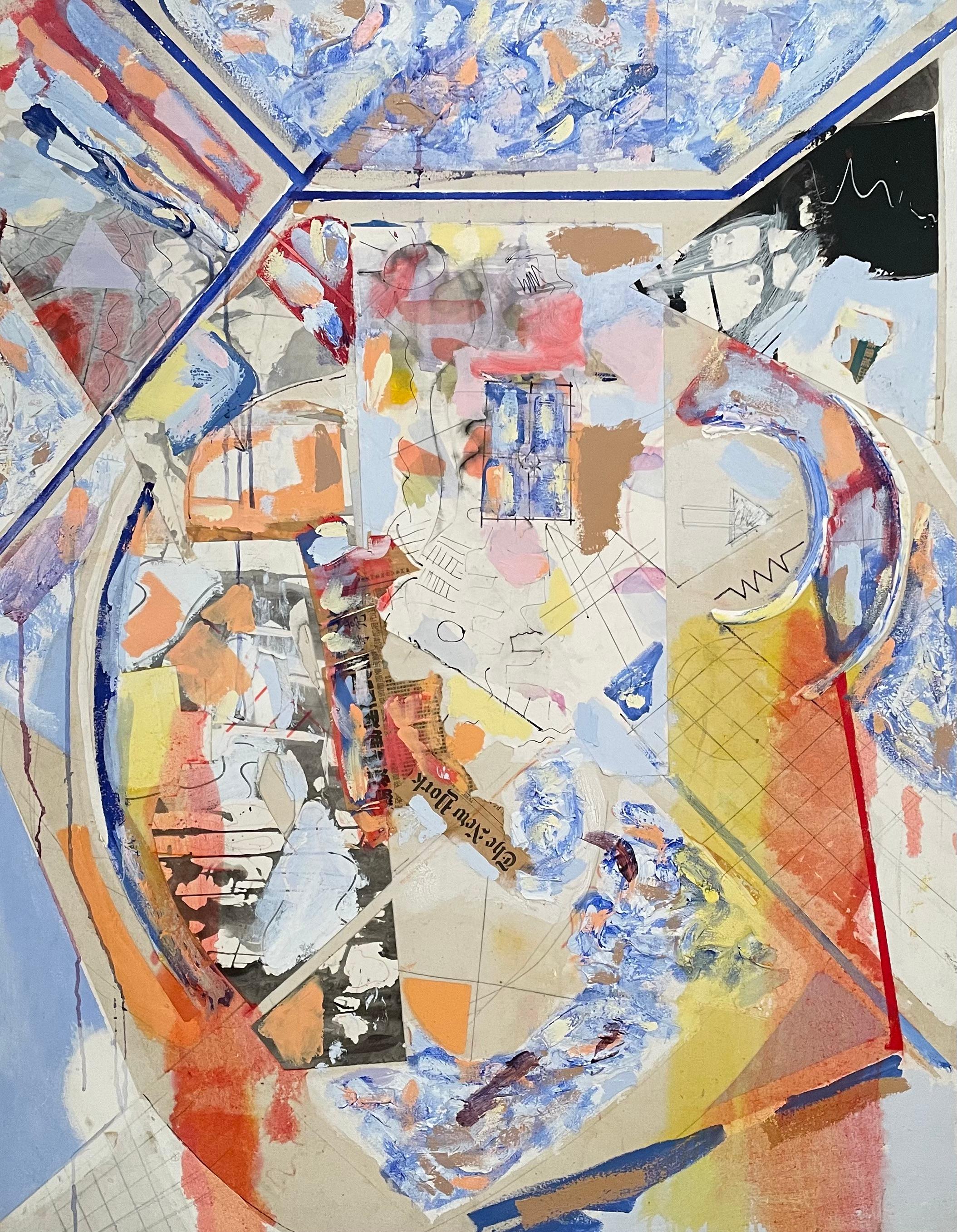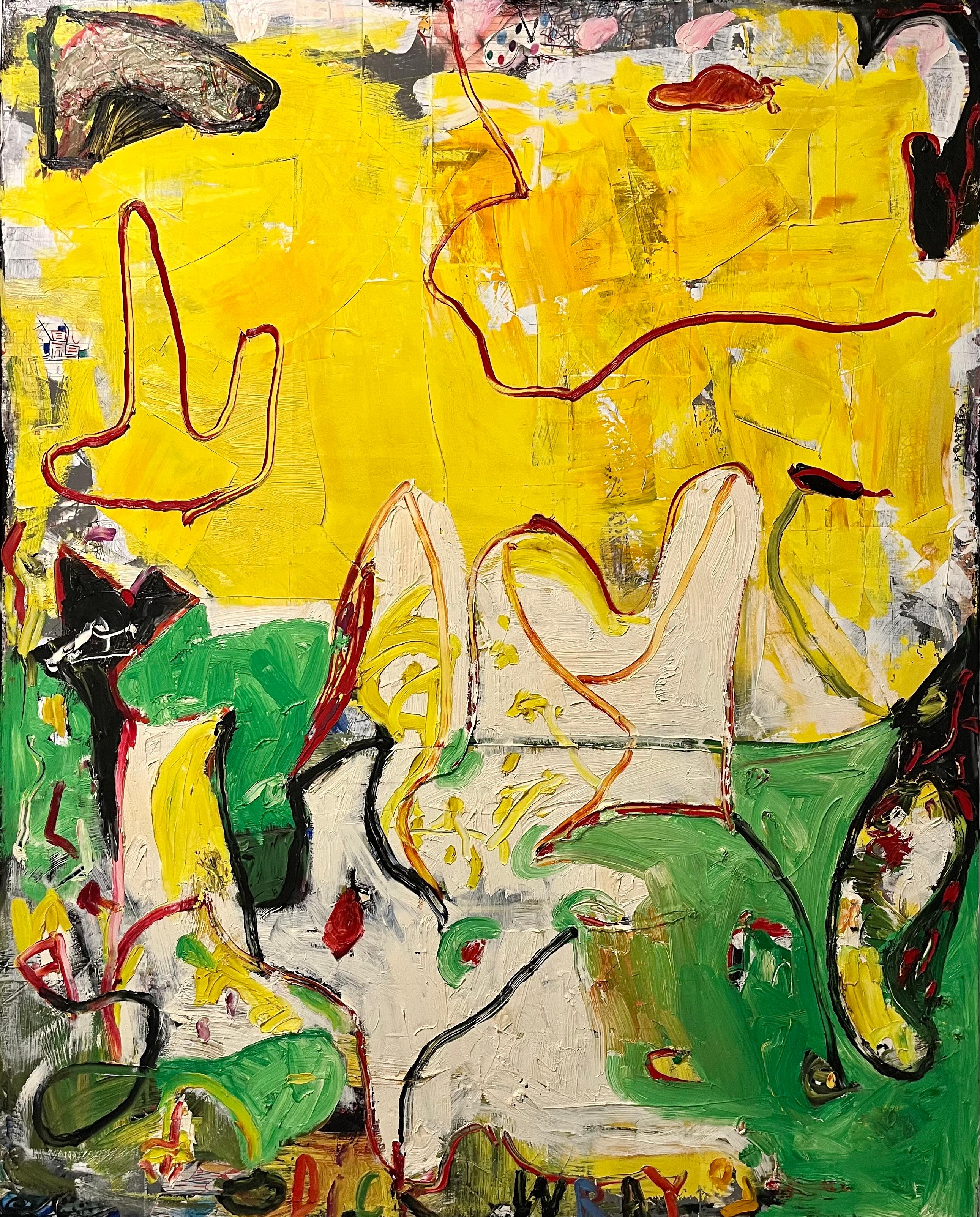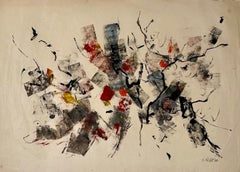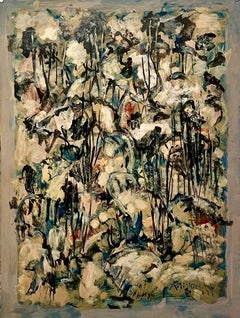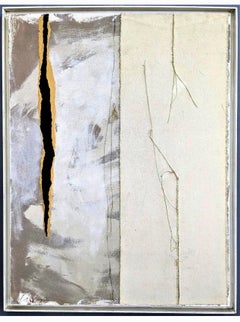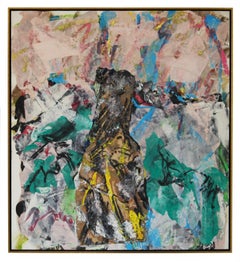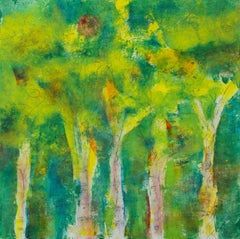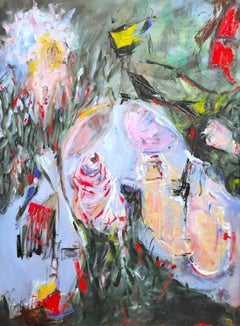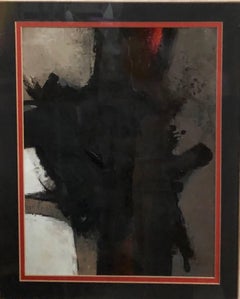
Abstract Expressionist Latin American Painting
View Similar Items
Want more images or videos?
Request additional images or videos from the seller
1 of 9
Ramon PratsAbstract Expressionist Latin American Painting
$1,200List Price
About the Item
- Creator:Ramon Prats (1928 - 2003, Spanish)
- Dimensions:Height: 25.5 in (64.77 cm)Width: 21.5 in (54.61 cm)
- Medium:
- Movement & Style:
- Period:
- Condition:frame has wear, needs to be reframed.
- Gallery Location:Surfside, FL
- Reference Number:1stDibs: LU3822529581
About the Seller
4.9
Platinum Seller
Premium sellers with a 4.7+ rating and 24-hour response times
Established in 1995
1stDibs seller since 2014
1,777 sales on 1stDibs
Authenticity Guarantee
In the unlikely event there’s an issue with an item’s authenticity, contact us within 1 year for a full refund. DetailsMoney-Back Guarantee
If your item is not as described, is damaged in transit, or does not arrive, contact us within 7 days for a full refund. Details24-Hour Cancellation
You have a 24-hour grace period in which to reconsider your purchase, with no questions asked.Vetted Professional Sellers
Our world-class sellers must adhere to strict standards for service and quality, maintaining the integrity of our listings.Price-Match Guarantee
If you find that a seller listed the same item for a lower price elsewhere, we’ll match it.Trusted Global Delivery
Our best-in-class carrier network provides specialized shipping options worldwide, including custom delivery.More From This Seller
View AllLarge Abstract Expressionist Oil Painting on Rice Paper Modernist John Von Wicht
Located in Surfside, FL
John von Wicht (American, 1888-1970)
Oil on Japanese Rice Paper. Hand signed and dated in pencil lower right.
Sheet Size: 21 x 29.25 in.
Johannes Von Wicht was born in Holstein, ...
Category
Mid-20th Century Abstract Expressionist Abstract Paintings
Materials
Oil Pastel, Oil, Rice Paper
French Argentine Modernist 74.47 Abstract Expressionist Painting
By Sergio de Castro
Located in Surfside, FL
Sergio de Castro (15 September 1922 – 31 December 2012) was a French-Argentinian
Sergio de Castro was born in Argentina, in an aristocratic family of Spanish origins (Galicia and the Basque Country), the House of Castro. His father was a diplomat, which is why, from 1923 until 1932, Castro lived in Switzerland with his parents and his two sisters. During these years he visited cities like Lausanne, Geneva and Turin.
In 1933 he entered a Jesuit school in Montevideo and he started studying music. He discovered poetry by learning to speak and write in Spanish. He was specially touched by the works of César Vallejo. Through the years Castro would become close friends with writers like Octavio Paz, Julio Cortázar, Samuel Beckett, Kostas Papaioannou and Georges Schéhadé. Later, during a trip to Uruguay, he met Joaquín Torres García, with whom he studied painting and monumental art from 1941 until 1949. In 1942 he moved to Argentina, where he would live until 1949. Castro was also friends with other artists like Nikos Hadjikyriakos-Ghikas, Maria Helena Vieira da Silva and Arpad Szenes.
In 1945 he found a job as a secretary in the Astronomy Observatorium of the city of Córdoba, where we also worked as the assistant to the musician Manuel de Falla in Alta Gracia, until his death in 1946. In 1945 and 1946 he had a grant from the French government to study musical composition. During the year of 1946 he had an exhibition in New York City among other members of Torres Garcia's workshop. That same year he traveled to the northeast of Argentina and the south of Perú to study pre-columbian art with Gonzalo Fonseca, Julio Uruguay Alpuy and Jonio Montiel.
In 1949 he started teaching History of Music in the new music school of the city of La Plata. His work as a musician drew attention from relevant figures such as Wilhelm Furtwängler, Aaron Copland and Juan José Castro. He quit this job when he got a grant from the French government to improve his musical studies in Paris, where he settled in November 1949. Since 1951 he devoted himself exclusively to painting.
In 1955, his friend the German writer and translator Edith Aron introduced him to Julio Cortázar, who would become a close friend of him. Castro inspired the character of Etienne in Cortázar's novel Rayuela (Hopscotch). In the book is featured the intimate friendship of the protagonist, Horacio Oliveira, with his companion in the Serpent Club, whom he often visited in his studio in Paris. In 1960 he won the Hallmark Prize in New York. In 1979 he obtained the French nationality.
In 1980 he showed his works at the Argentinian pavilion in the 39th Venice Biennale. He was associate professor in the Human Sciences Faculty of the University of Strasbourg from 1981 until 1986. In 1997 he became Officer in the Ordre des Arts et des Lettres. In 2006, Sergio de Castro made a 220-work donation to the Fine Arts Museum of Saint-Lô. He was also a close friend of the musician Alberto Ginastera, who made reference to Sergio de Castro and his first works in his notes on modern Argentinian music. Castro died 31 December 2012 in Paris. He is buried in the Montparnasse cemetery, in Paris, close to his dear friend Samuel Beckett.
Monumental works
Two wall paintings for the Martirené Pavilion of the Hospital Saint-Bois (1942), in Montevideo (Uruguay), in collaboration with Joaquín Torres García and his disciples, among which Castro was the youngest.
The Creation of the Universe (1956–1958), 6m x 20m stained-glass window. Castro worked with painter and glass-maker J. J. K. Ray (1898–1979) in Paris.
Selected Exhibitions
1952 Galerie Jeanne Castel Paris
1954 Galería Bonino Buenos Aires and Galerie Pierre Loeb, Paris
1956 Galerie Rive Gauche, Paris
1958 Matthiesen Gallery, London
1959 documenta 2 Kunst nach 1945 Kassel
1961 Matthiesen Gallery, London
1963–64 Galeria Lorenzelli, Bergamo and Milano
1964 Galería Bettie Thommen, Basel
1965 Kunstverein Hamburg Retrospektive
1966 Musée d'Art et d'Histoire, Fribourg, Switzerland (retrospective)
1966 Recklinhausen, Variationen über ein Thema, Städtische Kunsthalle
1970 Retrospektiven in Oslo, Kunstforering, and Kunst Industriemuseet, Copenhagen, Kunstforening, Oslo, Kunstforening, Holstebro
1972 Wildenstein Gallery, London Landscapes of Light
1974 Galerie Jacob, Paris
1975 Kunsthalle Bremen, Retrospektive, Berlin Tempelhof, Kunstamt (Berlin Festival)
1975–76 Retrospective exhibition the Musée des Beaux-Arts de Caen (68 artworks from 1956 to 1966), France
1979 Hommage à Pierre Loeb, Musée d'Art Moderne de la Ville de Paris
1980 39th Venice Biennale
1987 French Institute London. Museo de Arte Moderno de Buenos Aires
1988 Galerie des Ambassades y Galerie Galarte, Sergio de Castro, Natures Mortes, 1958–1965. Paris/ Bayeux, Diocesan Museum of Sacred Art
1989 Galerie des Ambassades, Paris
1991–92 Romont, Swiss Stained Glass...
Category
1970s Abstract Expressionist Abstract Paintings
Materials
Paper, Oil
Australian American D. Rankin Abstract Expressionist Oil Painting Rocky Hillside
By David Rankin
Located in Surfside, FL
David Rankin, American (b. 1946)
Rocky Hillside, (1990)
Oil on paper
Hand signed lower right, signed and titled verso.
30 x 22 1/2 inches
David Rankin is a New York-based, British-born Australian post-war and contemporary artist known for his expressionistic abstract paintings. His work can be categorized by his use of quick, loose brushstrokes, reminiscent of scribbles on a page. Rankin works predominantly in oil painting and acrylic on canvas, but also works with paper, prints, sculptures and ceramics. Rankin has held over 100 one-person exhibitions in cities across the world, including New York, London, Paris, Beijing, Mexico, Vienna, Berlin and Cologne, as well as all over Australia. Represented in many of the world’s leading public and private collections and museums, David Rankin’s work is featured in Australia’s leading institutions, including the National Gallery of Australia, Art Gallery of New South Wales, National Gallery of Victoria and Queensland Art Gallery.
David Rankin was born in Plymouth, Devon, England in 1946 then emigrated to Australia with his family in 1948. He spent his childhood in the 1950s in the semi-rural Port Hacking region South of Sydney and his teenage years in country New South Wales, from Hay, Wagga Wagga and Albury in the South to Bourke and Brewarrina in the North.
Rankin is self-taught, developing his techniques and ideas in the outback towns of his youth. He was inspired by the greats from Leonardo da Vinci to Paul Klee as well as being influenced by the history of Buddhism and Asian art. In his travels before he arrived in Sydney in 1967 he developed a concept of what he wanted to achieve as an Australian artist. His dream was to express the anima, the life spirit or the essence of God in all nature. As an Australian artist he believed could bring the elements of Western Art together with an understanding and love for the cultures of Asia and the Australian Aborigine. He also felt that as Australia was closer to Asia than Europe it made sense to think about the art of Indian, Chinese and Japanese artists, and that one could not be an authentic articulate Australian artist without a love and respect for the artistic and spiritual expressions of the various Aboriginal artists, peoples and cultures. His work combined elements of Abstract Expressionist painting with Jewish and Aboriginal influences.
In 1979 his first wife, Jennifer Mary Roberts (née Haynes) died. Rankin subsequently met his current wife Lily Brett, whose own life was etched by tragedy with her parents being survivors of the Holocaust. She too migrated to Australia as a child after the Second World War in 1948. The artist recounts that his empathy for Lily and the pity for his first wife's death fused into what he calls "the dark blessing of my life." The darkness was transformed into images. The author Dore Ashton writes that the events of 1979 and the fire which ravished his studio in 1997 and burnt his art works and many personal possessions, had a profound impact on his work.
Having personal life experiences as his subject matter, Rankin's paintings contemplate these things. For example, his Jerusalem series followed a trip to Jerusalem in 1988, which then led to his Golgotha works. His travels to the Australian, American and Mexican deserts became the subject matter for many of his canvases, such as Ridge – Mungo, Golden Prophecy – San Antonio, Grey Sonora Landscape and then led to his Witness Series. From the fire in his studio he then painted Buddha and Flames. He illustrated two books by Lily Brett on the holocaust and explored the theme further in his huge work The Drowned and The Saved from a book by Primo Levi of the same name. Through Brett he encountered Jewish mythology and painted judaica imagery, Black...
Category
1990s Abstract Expressionist Abstract Paintings
Materials
Oil, Paper
Mixed Media Collage Oil Painting Latvian American Modernist Artist Adja Yunkers
By Adja Yunkers
Located in Surfside, FL
Adja Yunkers, Latvian/American, 1900-1983.
1973
Mixed media collage painting with applied threads on canvas,
Titled "Collage #67".
Initialed "A. Y." and dated "'73" lower left, ...
Category
1970s Abstract Expressionist Abstract Paintings
Materials
Mixed Media, Fabric, Oil
Arc en Ciel Abstract Expressionist French Oil Painting Nouvelle École d'Paris
Located in Surfside, FL
Rene Duvillier (French, 1919-2002), "Arc en Ciel, Arc en Mer" 1990, oil on canvas, signed lower left, signed, titled, and dated verso, Provenance: gallery label from Galerie Mostini, Paris, France affixed verso,
canvas: 25.5"h x 32"w, overall (with frame): 27.5"h x 33.75"
Done in a bold, vibrant, blue with red and white.
René Duvillier (1919-2002) Born in Oyonnax (Ain) and died in 2002 in Paris. French artist. Painter of the new school in Paris.
Despite studying at the École nationale supérieure des beaux-arts de Paris (workshop of Charles Guerin, pupil of Gustave Moreau), Duvillier nevertheless asserted himself to be self-taught.
1939-1945: Five years of captivity. Duvillier was deported to Ukraine and then to Poland for several escape attempts and for acts of resistance.
1945: moves to Paris.
1952: A decisive meeting with Charles Estienne , an influential critic who tried to reconcile gestural abstraction and surrealist automatism. This integrates him into the group of painters of the new school in Paris which he shows at the gallery of Babylon. This is how Duvillier got to know Jean Degottex, Jean Messagier, Hans Hartung, Charles Lapicque and Serge Poliakoff. He was very much supported by the critic to whom great intellectual complicity links him.
1954-1955: René Duvillier, invited to Brittany by Charles Estienne , discovers the sea: "I found the movement and the gesture, it was a dreadful shock" explains the painter. Duvillier painted a series of polychrome canvases (black, purple, blue) on the sea as well as the series of "Seahorses", colored inks on paper. He was part of the New Ecole de Paris along with Nicolas de Staël, André Lanskoy, Pierre Soulages, and Jean René Bazaine.
1966: Contacts with scientists (CERN, School of Chemistry, Faculty of Geneva ). Duvillier discovers an astonishing similarity between some of his works and photos of physical and cosmic phenomena. Professor at the National School of Architecture of Versailles.
René Duvillier joined the Ecole des Beaux-Arts of Paris in 1935. After five years of captivity and an exhibition at the Stalag in Krakow, he joined the Nouvelle École de Paris. Under the guidance of the art critic Charles Estienne, it gathered painters from Surrealism and gesture or lyric abstraction that finally won the art scene in 1955. André Breton exhibited him and Benjamin Péret exalted his pictorial work, in which the brush movement brings to life natural elements, sea striking rocks and giving them almost supernatural attributes (1955).
Select exhibitions
2010 - Ivre de peinture, Galerie Alain Margaron, Paris
2009 - René Duvillier, Galerie L'Or du Temps, Paris
2008 - Vous êtes le feu dans l'eau, Galerie Alain Margaron, Nice
2003 - Accrochage d'oeuvres de René Duvillier, Galerie Larock-Granoff, Paris
2003 - Ici - Ailleurs, Galerie Doris Benno, Saint-Paul-De-Vence
1999 - À l'Ouest du Monde, FIAC, Paris
1993 - Le ciel de la mer, Galerie Larock-Granoff, Paris
1987 - Peintures 1955-1983, Galerie Mostini, Paris
1986 - Galerie du Manoir, La Chaux de Fonds, Suisse
1971 - Ensemble de Peinture, Palais des Expositions, Genève
1970 - Têtes Chercheuses, Galerie Le Lutrin, Lyon
1965 - Benrath et Duvillier, Galerie Argos, Nantes
1964 - Galerie Byron, New York
1961 - La Mer des Vents, Galerie Smith, Bruxelles
1943 - La Genése, Stalag de Cracovie, Kobierzyn
Select Group Exhibitions
2017 - Ailleurs est ici, École des Filles, Huelgoat
2017 - Le geste et la matière une abstraction "autre" Paris, 1945-1965, Fondation Clément/Centre Pompidou, Martinique
2011 - L'Aventure de l'Art Abstrait, Musée des Beaux-Arts de Brest, Brest
2008 - Les Nuagistes, Collégiale Saint-André, Chartres
2002 - Art ou Nature ?, Musée du Luxembourg, Luxembourg
1999 - Actualité des collections du XXe siècle 1996-1999, musée des Beaux-Arts, Lyon
1999 - L'Intimité des dessins, Galerie Alain Margaron, Paris
1997 - Un combat pour l'Art Moderne, Hommage à René Déroudille., Musée des Beaux-Arts de Lyon, Lyon
1995 - Nantes et le surréalisme, Musée des beaux-arts de Nantes, Nantes
1991 - André Breton, La beauté convulsive, Centre George Pompidou, Paris
1990 - André Breton, Musée national, Madrid
1989 - I Surrealisti, Palazzo Reale, Milan
1987 - Le Visionnaire, Galerie du Manoir, La Chaux de Fonds, Suisse
1986 - Blanc/Noir/Blanc, Centre Culturel de Landerneau et Musée des Jacobins, Morlaix
1984 - Autour de Michel Ragon, Paris Art Center, Paris
1981 - Paris-Paris 1937-1957, Centre Georges Pompidou, Paris
1980 - Bilan de l'art contemporain, Palais des Congrès, Québec
1973 - Exposition internationale du dessin original...
Category
1990s Abstract Expressionist Abstract Paintings
Materials
Canvas, Oil
Brazilian Modernist Abstract Oil Painting Latin American Expressionist Concreta
Located in Surfside, FL
Abstract oil on canvas painting by Ivan Freitas.
25" x 31" inch canvas, framed to 30" x 36".
Bearing a Barcinski Art Gallery label verso and a second label stating that the painting was sold in 1961 at a benefit auction for the Albert Einstein Hospital held at the Museum of San Paulo.
Ivan Freitas was a Brazilian Postwar & Contemporary painter and Muralist (1932-2006)
Son of muralist Severino Araújo, Ivan started painting as a self-taught artist.
His first individual exhibition was at the Public Library, in 1957. With the success of the exhibition, he was able to move to Rio de Janeiro the following year, in 1958, where he came into contact with the work of artists such as Salvador Dali and Rene Magritte who influenced him. Between 1962 and 1963 he resided as a fellow in Paris. Between 1969 and 1972, he was on his second tour abroad, in New York City and commissioned by the International Telephone and Telegraph Corporation.
Back in Brazil, he painted a mural of over a thousand square meters on the external wall of the National School of Music in Rio de Janeiro in 1984 - the first of the Arte nos Muros Project. Still in the 70s, he married Dalva Mendes Gall whom he left after his death in 200, an extensive collection where one can find all the best works of this renowned Paraiba artist in Brazil and abroad.
The stay in New York, from 1969 to 1972, was perhaps the greatest turning point in Ivan's career. Until then, according to art critic Roberto Pontual, the plastic artist followed "a phase of abstraction close to the informal". In the United States , with so much technological influence around him, Ivan becomes interested in the machine and its movement mechanisms and inserts these perceptions in his works, as kinetic constructions with small motors hidden in boxes as Pontual defines, and also and triggering light patterns in cyclic and repeated series. (similar to the Op Art works of Julio le Parc and works by Yves Tinguely being shown at Rene Denis Gallery in Paris
In 1968, the magazine Galeria de Arte Moderna (GAM), published an article entitled Ivan Freitas and the Cosmic Space.
In the Brazilian Dictionary of Plastic Artists , the Italian art critic Giuseppe Marchiori refers to Ivan Frentas as someone who "controls and dominates each part of the painting with a desire to deepen the image that surprises and enchants". Still according to the critic, Ivan is someone who preserves the mystery in the harmony between lines and the colorful atmosphere, where he creates pauses and rhythms for the reading of his "secret structures". Arte Neo Concreta artists Lygia Clark, Helio Oiticica and Lygia Pape, were all contemporaries
The poet Ferreira Gullar writes: "Freitas does not turn to the subjective world, does not inquire into the arcana of the unconscious; he inquires into the future and, in the solitude of his paintings, promises us a serene and orderly world. And, if in his landscapes man does not appear, it is not that this order excludes him - it is that he has not yet reached it. "
Selec Solo Exhibitions
1957 - João Pessoa Public Library; João Pessoa, PB.
1960 - Ivan Freitas: Painting Exhibitions , at the Penguin Gallery; Rio de Janeiro - RJ.
1961 - MAM-BA , Salvador , BA.
1962 - Rubbers Gallery; Buenos Aires , Argentina .
1962 - La Cabana Galeria; Trieste , Italy .
1962 - Brazil-United States Cultural Institute; Rio de Janeiro - RJ.
1962 - Brazil-Uruguay Institute; Montevideo , Uruguay .
1962 - Barcinski Gallery; Rio de Janeiro - RJ.
1963 - Galleria Del Canale, Naples , Italy.
1963 - Ivan Freitas: Paris 1963, at the Barcinski Gallery ; Rio de Janeiro - RJ.
1964 - Barcinski Gallery; Rio de Janeiro - RJ.
1966 - Relief Gallery; Rio de Janeiro - RJ.
1968 - Relief Gallery; Rio de Janeiro - RJ.
1969 - Pan American Union; Washington , United States.
1971 - Miramar Gallery; New York, United States.
1971 - Bloomingdale's Art Gallery; New York, United States.
1973 - Individual, at Galeria Bonino; Rio de Janeiro - RJ.
1973 - Galeria Collection; São Paulo , SP.
1974 - Ivan Freitas: Paintings / Objectives , at the Rio de Janeiro Art Exchange; Rio de Janeiro - RJ.
1975 - Arte Global Gallery; São Paulo-SP.
1976 - Ivan Freitas: Paintings / Space / Movement , at Galeria Ipanema; Sao Paulo-SP.
1977 - Paulo Prado Gallery; Sao Paulo-SP.
1978 - Paraíba State Cultural Foundation; João Pessoa, PB.
1979 - Gallery B. 75 Concorde; Rio de Janeiro - RJ.
1980 - Individual, at Galeria do Sesi; Sao Paulo-SP.
1980 - Paulo Prado Gallery; Sao Paulo-SP.
1986 - Ivan Freitas: The Reinvented Landscape , at Galeria Arte Aplicada; Sao Paulo-SP.
1987 - Applied Art Gallery; Sao Paulo-SP.
1989 - Evasion Arte Gallery; Sao Paulo-SP.
1994 - GB Arte Gallery; Rio de Janeiro - RJ.
Select Group Exhibitions
1959 - 8th National Salon of Modern Art; Rio de Janeiro - RJ.
1960 - 9th National Salon of Modern Art; Rio de Janeiro - RJ.
1961 - 10th National Salon of Modern Art - jury exemption and critical award; Rio de Janeiro - RJ.
1961 - 6th São Paulo International Art Biennial , at the Ciccilo Matarazzo Pavilion; Sao Paulo-SP.
1963 - Art from America and Spain; Europe .
1963 - 2nd Youth Biennial; Paris, France.
1963 - 7th São Paulo International Art Biennial, at the Fundação Bienal; ; Sao Paulo-SP.
1964 - 2nd Art Summary of Jornal do Brasil, at MAM-RJ; Rio de Janeiro - RJ.
1965 - Current Brazilian Art; Bonn , Germany .
1965 - Current Brazilian Art; London , England .
1965 - 1st Esso Young Artists Salon, at MAM-RJ; Rio de Janeiro - RJ.
1965 - Opinion 65, at MAM / RJ; Rio de Janeiro - RJ.
1965 - 1st Esso Salon of Young Artists, at MAC / USP; Sao Paulo-SP.
1965 - 8th São Paulo International Art Biennial, at the Fundação Bienal; Sao Paulo-SP.*
1965 - Current Brazilian Art; Vienna , Austria .
1966 - 5 Contemporary Painters from Brazil; Buenos Aires, Argentina.
1966 - 5 Contemporary Painters from Brazil; Montevideo, Uruguay.
1966 - 1st National Biennial of Plastic Arts; Salvador BA.
1967 - 9th Bienal Internacional de Arte de São Paulo, at the Bienal Foundation; Sao Paulo-SP.
1968 - 2nd Esso Young Artists Salon, at MAM / RJ; Rio de Janeiro - RJ.
1969 - 7th JB Art Summary, at MAM-RJ ; Rio de Janeiro - RJ.
Local de realização:(Brasil / Rio de Janeiro / Rio de Janeiro) Instituição de realização:Museu de Arte Moderna do Rio de Janeiro, Ficha Técnicado evento Resumo de Arte JB
Artista participante: Anna Letycia, Darel, Farnese de Andrade, Fayga Ostrower, Flexor, Frans Krajcberg, Ione Saldanha...
Category
1960s Abstract Expressionist Abstract Paintings
Materials
Canvas, Oil
You May Also Like
Untitled
By Michael Goldberg
Located in Austin, TX
Waterline Fine Art, Austin, TX is pleased to present the following work:
Oil, pastel, and paper collage on canvas. Signed and dated verso.
52.75 x 47.75 in.
54 x 49 in. (framed)
Gilded floater frame.
Provenance
Compass Rose, Chicago
Born Sylvan Irwin Goldberg in 1924 and raised in the Bronx, Michael Goldberg was an important figure in American Abstract Expressionism, who began taking art classes at the Art Students League in 1938. A gifted student, Goldberg finished high school at the age of 14 and enrolled in City College. He soon found New York’s jazz scene to be a more compelling environment, and he began skipping classes in favor of the Harlem jazz clubs near campus. Goldberg’s love of jazz would become a lifelong passion and a key component to his approach to composition in his paintings.
From 1940 to 1942, like many of the leading artists of the New York School, Goldberg studied with Hans Hofmann. In 1943, he put his pursuit of painting on hold and enlisted in the U.S. Army. Serving in North Africa, Burma, and India, Goldberg received a Purple Heart and a Bronze Star before being discharged in 1946. After his service, he traveled and worked in Venezuela before returning to the United States, settling back in New York and resuming studies with Hofmann and at the Art Students League.
Living downtown and frequenting the Cedar Bar, Goldberg befriended many of the artists of the New York School. In 1951, his work was included in the groundbreaking Ninth Street Show, co-organized by Leo Castelli, Conrad Marca-Relli, and the Eighth Street Club, and featuring the work of - among others - Hofmann, Jackson Pollock, Willem de Kooning, and Franz Kline. In 1953, the Tibor de Nagy...
Category
1980s Abstract Expressionist Abstract Paintings
Materials
Canvas, Pastel, Mixed Media, Oil, Handmade Paper
It's Springtime Somewhere in the World
Located in Austin, TX
"It's Springtime Somewhere In the World" is an abstract painting by Rebecca Sobin executed in oil, cold wax medium, and pastel powder, and rice paper on a cradled wood panel; measuri...
Category
21st Century and Contemporary Abstract Expressionist Abstract Paintings
Materials
Wax, Oil, Wood Panel, Rice Paper, Graphite
Leaves I
By Fritz Bultman
Located in New Orleans, LA
Floated on archival white mat with wood frame.
Fritz Bultman set himself apart from other Abstract Expressionists with his meticulously organized abstract compositions, use of sculp...
Category
1950s Abstract Expressionist Abstract Paintings
Materials
Oil, Paper
Price Upon Request
Night Swim /// Contemporary Abstract Expressionist Oil Painting Female Artist
By Margaux Halloran
Located in Saint Augustine, FL
Artist: Margaux Halloran (American, 1999-)
Title: "Night Swim"
*Monogram signed by Halloran in gold pen lower right
Year: 2021
Medium: Original Oil Painting on Canvas paper
Framing: ...
Category
2010s Abstract Expressionist Abstract Paintings
Materials
Canvas, Paint, Paper, Oil
II. 2011-2013. Paper, plastic glass, oil, 90x68 cm
By Verners Lazdans
Located in Riga, LV
II. 2011-2013. Paper, plastic glass, oil, 90x68cm
Category
2010s Abstract Expressionist Abstract Paintings
Materials
Plastic, Paper, Oil
$1,537 Sale Price
20% Off
V. 2011-2013. Paper, plastic glass, oil, 90x68 cm
By Verners Lazdans
Located in Riga, LV
2011-2013. Paper, plastic glass, oil, 90x68cm
Category
2010s Abstract Expressionist Abstract Paintings
Materials
Paper, Plastic, Oil
$1,537 Sale Price
20% Off

